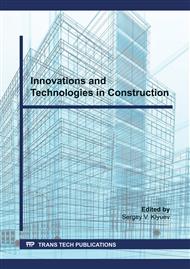[1]
H. Huang, C. Qian, F. Zhao, J. Qu, J. Guo, M. Danzinger, Improvement on microstructure of concrete by polycarboxylate superplasticizer (PCE) and its influence on durability of concrete, Constr. Build. Mater. 110 (2016) 293-299. https://doi.org/10.1016/j.conbuildmat.2016.02.041.
DOI: 10.1016/j.conbuildmat.2016.02.041
Google Scholar
[2]
O.M. Smirnova, Compatibility of portland cement and polycarboxylate-based superplasticizers in high-strength concrete for precast constructions, Magazine of Civil Engineering 66(6) (2016) 12-22. https://doi.org/10.5862/MCE.66.2.
DOI: 10.5862/mce.66.2
Google Scholar
[3]
F. Lollini, E. Redaelli, L. Bertolini, Effects of portland cement replacement with limestone on the properties of hardened concrete, Cem. Concr. Compos. 46 (2014) 32-40. https://doi.org/10.1016/j.cemconcomp.2013.10.016.
DOI: 10.1016/j.cemconcomp.2013.10.016
Google Scholar
[4]
G. Le Saoût, B. Lothenbach, A. Hori, T. Higuchi, F. Winnefeld, Hydration of Portland cement with additions of calcium sulfoaluminates, Cem. Concr. Res. 43(1) (2013) 81-94. https://doi.org/10.1016/j.cemconres.2012.10.011.
DOI: 10.1016/j.cemconres.2012.10.011
Google Scholar
[5]
K. Celik, R. Hay, C.W. Hargis, J. Moon, Effect of volcanic ash pozzolan or limestone replacement on hydration of Portland cement, Constr. Build. Mater. 197 (2019) 803-812. https://doi.org/10.1016/j.conbuildmat.2018.11.193.
DOI: 10.1016/j.conbuildmat.2018.11.193
Google Scholar
[6]
P. Carballosa, J.L. García Calvo, D. Revuelta, J.J. Sánchez, J.P. Gutiérrez, Influence of cement and expansive additive types in the performance of self-stressing and self-compacting concretes for structural elements, Constr. Build. Mater. 93 (2015) 223-229. https://doi.org/10.1016/j.conbuildmat.2015.05.113.
DOI: 10.1016/j.conbuildmat.2015.05.113
Google Scholar
[7]
J.D.S. Jacob, A.G. Mascelani, R.L.R. Steinmetz, F.A.D. Costa, O.A. Dalla Costa, Use of silica fume and nano-silica in mortars attacked by acids present in pig manure, Procedia Structural Integrity 11 (2018) 44-51. https://doi.org/10.1016/j.prostr.2018.11.007.
DOI: 10.1016/j.prostr.2018.11.007
Google Scholar
[8]
A.S. Rassokhin, A.N. Ponomarev, O.L. Figovsky, Silica fumes of different types for high-performance fine-grained concrete, Magazine of Civil Engineering 78(2) (2018) 151-160. https://doi.org/10.18720/MCE.78.12.
Google Scholar
[9]
Y. Kocak, Effects of metakaolin on the hydration development of Portland–composite cement, J. Build. Eng. 31 (2020) 101419. https://doi.org/10.1016/j.jobe.2020.101419.
DOI: 10.1016/j.jobe.2020.101419
Google Scholar
[10]
S.S.S.A. Nedunuri, S.G. Sertse, S. Muhammad, Microstructural study of Portland cement partially replaced with fly ash, ground granulated blast furnace slag and silica fume as determined by pozzolanic activity, Constr. Build. Mater. 238 (2020) 117561. https://doi.org/10.1016/j.conbuildmat.2019.117561.
DOI: 10.1016/j.conbuildmat.2019.117561
Google Scholar
[11]
T.A. Nizina, A.S. Balykov, D.I. Korovkin, V.V. Volodin, Modified fine-grained concretes based on highly filled self-compacting mixtures, IOP Conference Series: Materials Science and Engineering 481(1) (2019) 012048. https://doi.org/10.1088/1757-899X/481/1/012048.
DOI: 10.1088/1757-899x/481/1/012048
Google Scholar
[12]
T.A. Nizina, A.S. Balykov, V.V. Volodin, D.I. Korovkin, Fiber fine-grained concretes with polyfunctional modifying additives, Magazine of Civil Engineering 72(4) (2017) 73-83. https://doi.org/10.18720/MCE.72.9.
DOI: 10.5862/mce.62.2
Google Scholar
[13]
R.Z. Rakhimov, N.R. Rakhimova, A.R. Gayfullin, V.P. Morozov, Effect of the Addition of Thermally Activated Heavy Loam to Portland Cement on the Properties of Cement Stone, Inorg. Mater.: Appl. Res. 9(4) (2018) 679-686. https://doi.org/10.1134/S2075113318040330.
DOI: 10.1134/s2075113318040330
Google Scholar
[14]
A.R. Gaifullin, R.Z. Rakhimov, N.R. Rakhimova, The influence of clay additives in Portland cement on the compressive strength of the cement stone, Magazine of Civil Engineering 59(7) (2015) 66-73. https://doi.org/10.5862/MCE.59.7.
DOI: 10.5862/mce.59.7
Google Scholar
[15]
G. Habert, N. Choupay, G. Escadeillas, D. Guillaume, J.M. Montel, Clay content of argillites: Influence on cement based mortars, Appl. Clay Sci. 43(3-4) (2009) 322-330. https://doi.org/10.1016/j.clay.2008.09.009.
DOI: 10.1016/j.clay.2008.09.009
Google Scholar
[16]
R. Fernandez, F. Martirena, K.L. Scrivener, The origin of the pozzolanic activity of calcined clay minerals: A comparison between kaolinite, illite and montmorrilonite, Cem. Concr. Res. 41(1) (2011) 113-122. https://doi.org/10.1016/j.cemconres.2010.09.013.
DOI: 10.1016/j.cemconres.2010.09.013
Google Scholar
[17]
C. He, B. Osbaeck, E. Makovicky, Pozzolanic reactions of six principal clay minerals: Activation, reactivity assessments and technological effects, Cem. Concr. Res. 25(8) (1995) 1691-1702. https://doi.org/10.1016/0008-8846(95)00165-4.
DOI: 10.1016/0008-8846(95)00165-4
Google Scholar
[18]
B.B. Sabir, S. Wild, J. Bai, Metakaolin and calcined clays as pozzolans for concrete: a review, Cem. Concr. Compos. 23(6) (2001) 441-454. https://doi.org/10.1016/S0958-9465(00)00092-5.
DOI: 10.1016/s0958-9465(00)00092-5
Google Scholar
[19]
A. Tironi, C.C. Castellano, V.L. Bonavetti, M.A. Trezza, A.N. Scian, E.F. Irassar, Kaolinitic calcined clays – Portland cement system: Hydration and properties, Constr. Build. Mater. 64 (2014) 215-221. https://doi.org/10.1016/j.conbuildmat.2014.04.065.
DOI: 10.1016/j.conbuildmat.2014.04.065
Google Scholar


